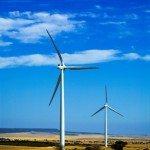Yesterday, a group of central New South Wales locals gathered in a state-of-the-art, solar-passive sustainability centre in Bathurst for the official formation meeting and launch of the Central NSW Renewable Energy Cooperative (CENREC).
CENREC is a co-op of 14 people from Orange, Blayney and Bathurst that’s been about a year in the making, and it has a couple of pretty impressive goals: To raise community-sourced funds to purchase one of the 44 wind turbines that will make up Infigen Energy’s proposed 115MW wind farm at Flyers Creek, south of Orange; and to act as a low-carbon hub for the community, providing information on such things as improving household energy efficiency, and which grants or solar options are available.
It’s not the first co-op dedicated to promoting renewable energy in regional Australia, nor is it the first to invest in wind farm development – the 4.1MW Hepburn Community Wind Farm, which started exporting power to the grid in June last year, is wholly community-owned by Victorian co-op Hepburn Wind. But it is the first to adopt this particular model of renewables investment, popular in Europe, of buying a small stake in a large-scale project.
CENREC’s plan is to buy a turbine and then sell the electricity it produces to a retailer. At a total cost of $6.3 million, it’s not a small investment, but then, as the co-op’s CEO Jess Jennings told the Western Advocate in an interview published Tuesday, they will be looking at generating 9200MWh of energy a year, “which is the equivalent of providing the energy needs of approximately 1300 houses per year, or powering 10 per cent of Bathurst homes.”
The minimum investment is $1000, and for this, participants would get 1000 shares, a return on investment ranging from 8 per cent (with the carbon tax) to 6.5 per cent (without), as well as a vote in the co-op, and the satisfaction of knowing that their one turbine would see the elimination of 6800 tonnes of greenhouse gas emissions over its projected life of 20 years – the 43 other turbines in the yet-to-be-approved Infigen project would see a GHG reduction of six million tonnes.
“The return on the investment won’t be realised until the electricity generated is sold, which will take 18 months to two years, so it is a medium to long-term investment,” said Dr Jennings, adding that there had been strong interest in the project thus far. “We need to get a legal entity formed to allow people to express their interest in a tangible way,” he said. “The project is increasing efficiency and the transition to a low carbon economy. It is walking the talk, with or without a carbon tax.”
And there are other, much broader, benefits of this model, too. As Treehugger reported in August last year, research out of Europe has suggested that local ownership of renewable energy projects, and particularly wind farms, “can make the difference between full-scale acceptance and outright rejection.” A Germany study has shown that community rejection of wind farms – otherwise known as NIMBYism – is often fueled by a notion that outside parties are benefiting from a local resource.
And that is where a co-op like CENREC can make all the difference, by getting the community educated, involved and in on the game of profiting from renewables. As CENREC chairman Pat Bradbury put it in an interview with ABC Radio this week, it’s about taking the power away from money and giving it back to people: “Because it doesn’t matter how many shares you own… you have one vote.”
But he adds, “education, education and education are the first three things that a co-op needs to look at.” And in CENREC’s case, it’s education about “opportunity for and the reason for having renewable energy as a central part of our life.”
If, and when, the Flyers Creek wind farm gains final approval – Infigen is awaiting a decision from the state government on the project’s environmental impact statement, and is confident it will be approved by the end of the year – the co-op’s focus might need to shift to capital raising. Bradbury says they are aiming to raise a baseline of $5 million, and borrow another $3 million “from normal commercial sources.” That, he says, “will allow us to become the owners of turbine number XYZ at the Flyers Creek Wind Farm.”










